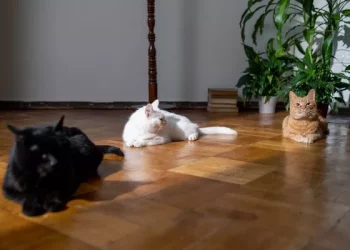The Chartreux cat, known for its striking blue-gray coat and engaging personality, is a breed that has captured the hearts of cat lovers worldwide. Originally from France, these cats are not only beloved for their unique appearance but also for their playful yet calm demeanor. As responsible pet owners, it’s crucial to understand the dietary requirements of the Chartreux to ensure their health and longevity. In this article, we will delve into how much a Chartreux cat should eat, considering factors such as age, weight, activity level, and overall health.
Before discussing their dietary needs, let’s take a moment to appreciate what makes the Chartreux cat so special. This breed is characterized by:
Distinctive Appearance: Chartreux cats have a robust, muscular body and a dense, water-repellent coat that is typically a striking blue-gray color. Their large, round copper or gold eyes give them a unique charm.
Temperament: Known for being gentle, intelligent, and playful, Chartreux cats form strong bonds with their families. They are known to be good with children and other pets, making them an excellent choice for many households.
Understanding these traits helps us appreciate their needs, including their nutritional requirements.
Basic Nutritional Needs of Cats
Before we narrow down the specific needs of the Chartreux, let’s review the general dietary requirements of cats. Cats are obligate carnivores, which means their diet must primarily consist of meat. Here are key nutrients that should be included in their diet:
Proteins: Essential for growth, repair, and maintenance of body tissues. High-quality animal proteins should be the primary source of nutrition.
Fats: Provide energy and are important for healthy skin and coat. Fatty acids, particularly omega-3 and omega-6, are vital for overall health.
Carbohydrates: While cats do not require carbohydrates in the same way that dogs do, some carbohydrates can provide energy and fiber.
Vitamins and Minerals: Essential for various bodily functions, including immune system support and bone health.
How Much Should a Chartreux Cat Eat?
The amount a Chartreux cat should eat can vary based on several factors. Here’s a breakdown to help you determine the right portion sizes for your furry friend.
Age
Kittens: Chartreux kittens need more calories per pound of body weight than adults due to their rapid growth. Generally, a growing kitten should consume around 4-6 meals a day. They typically require 30-40 calories per pound of body weight.
Adults: Once they reach maturity (around 1 year old), Chartreux cats generally require about 20 calories per pound of body weight. This translates to about 200-300 calories per day, depending on their size and activity level.
Senior Cats: As cats age, their metabolism slows down. Senior Chartreux cats may require fewer calories, around 15-20 calories per pound of body weight, and it’s essential to monitor their weight to prevent obesity.
Weight
Maintaining a healthy weight is crucial for a Chartreux cat. An average adult Chartreux weighs between 8-15 pounds.
Underweight Cats: If your cat is underweight, it may need to consume more calories. A veterinarian can provide a specific feeding plan.
Overweight Cats: Obesity is a common issue in indoor cats. If your Chartreux is overweight, consider reducing calorie intake and increasing physical activity.
Activity Level
The activity level of your Chartreux significantly impacts their caloric needs:
Active Cats: If your Chartreux is playful and enjoys regular play sessions, they may require more calories.
Sedentary Cats: Indoor cats that are less active may need fewer calories to maintain a healthy weight.
Health Considerations
Specific health issues may require dietary adjustments. Here are a few examples:
Diabetes: Cats with diabetes may need a high-protein, low-carbohydrate diet.
Kidney Disease: Cats with kidney issues often benefit from a diet lower in protein and phosphorus.
Consulting with a veterinarian is essential to tailor a diet that meets your cat’s health needs.
Types of Food for Chartreux Cats
Understanding the types of food available is vital in meeting your Chartreux’s dietary needs.
Dry Food vs. Wet Food
Both dry and wet foods have their benefits:
Dry Food: Convenient and helps keep teeth clean. However, it is generally lower in moisture content, which is essential for urinary health.
Wet Food: Higher moisture content helps maintain hydration and is often more palatable. It can be beneficial for cats prone to urinary tract issues.
Commercial vs. Homemade Diets
Commercial Diets: Many high-quality commercial cat foods are designed to meet the nutritional needs of cats. Look for products labeled as “complete and balanced.”
Homemade Diets: Some owners choose to prepare homemade diets for their cats. If you opt for this route, it’s vital to work with a veterinarian or a pet nutritionist to ensure the diet is nutritionally balanced.
Grain-Free Diets
Grain-free diets have gained popularity, but it’s important to note that not all cats require them. Some cats may thrive on diets that include grains, while others might have allergies or sensitivities.
Feeding Schedule
Establishing a consistent feeding schedule helps regulate your Chartreux’s eating habits.
Meal Frequency
Kittens: Feed kittens several small meals throughout the day.
Adults: Most adult cats do well with two meals per day.
Portion Control
Using a measuring cup ensures you are feeding the appropriate portion size. Avoid free-feeding (leaving food out all day) unless your cat can regulate its intake.
Monitoring Your Chartreux’s Weight
Regularly monitoring your cat’s weight is crucial for maintaining its health. Here are some tips:
Weighing: Weigh your cat every few weeks, especially if you’re making dietary changes.
Body Condition Scoring: Familiarize yourself with body condition scoring to assess whether your cat is at a healthy weight.
Signs of Overfeeding or Underfeeding
Understanding your cat’s body language and habits can help you recognize if you’re feeding them appropriately.
Overfeeding Signs
Weight Gain: Noticeable increase in weight.
Lethargy: Less active than usual.
Difficulty Grooming: Overweight cats may struggle to groom themselves.
Underfeeding Signs
Weight Loss: Rapid or significant loss of weight.
Increased Hunger: Constantly begging for food or exhibiting signs of hunger.
Poor Coat Condition: A lack of nourishment may result in a dull coat.
Treats and Supplements
While it’s important to focus on a balanced diet, treats can play a role in your Chartreux’s nutrition.
Treats
Healthy Options: Opt for treats that are high in protein and low in fillers.
Moderation: Treats should not make up more than 10% of your cat’s daily caloric intake.
Supplements
Consult with your veterinarian before introducing any supplements. In some cases, specific supplements may benefit your Chartreux’s health, but they should never replace a balanced diet.
Common Feeding Myths
Several myths surround cat feeding that can lead to confusion. Here are a few:
Myth: Cats can survive on a vegetarian diet.
Truth: Cats are obligate carnivores and require meat in their diet.
Myth: All cats self-regulate their food intake.
Truth: Not all cats will self-regulate; some may overeat if food is always available.
Conclusion
Feeding a Chartreux cat requires attention to detail, understanding of their unique needs, and a commitment to their health. By considering factors such as age, weight, activity level, and specific health conditions, you can create a tailored feeding plan. Always consult with your veterinarian to ensure your Chartreux cat receives the best possible nutrition, promoting a healthy, happy life.
Understanding how much a Chartreux should eat and providing balanced nutrition is essential in maintaining their health and well-being. With proper care, these delightful felines can live long, fulfilling lives as cherished members of your family.
Related Topics:
























